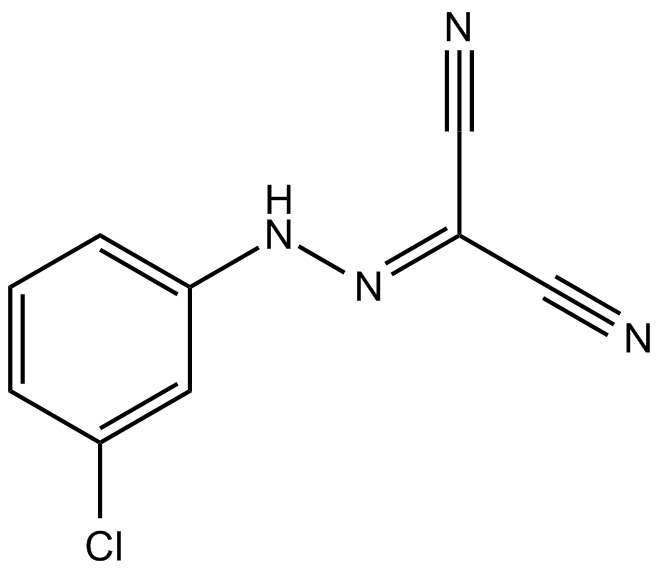CCCP (Synonyms: Carbonyl cyanide m-chlorophenyl hydrazone, NSC 88124) |
| Catalog No.GC14727 |
Carbonylcyanide-3-chlorophenylhydrazone (CCCP) is a protonophore, which causes uncoupling of proton gradient in the inner mitochondrial membrane, thus inhibiting the rate of ATP synthesis.
Products are for research use only. Not for human use. We do not sell to patients.

Cas No.: 555-60-2
Sample solution is provided at 25 µL, 10mM.
Carbonylcyanide-3-chlorophenylhydrazone (CCCP) is a protonophore, which causes uncoupling of proton gradient in the inner mitochondrial membrane, thus inhibiting the rate of ATP synthesis. CCCP inhibits STING-mediated IFN-β production via disrupting mitochondrial membrane potential (MMP).
In HL-7702 cells, Mitochondrial inducer CCCP activates mitophagy. CCCP failed to selectively reduce COX6A1 levels[1]. CCCP alone significantly increased chondrocyte apoptosis treatment with CCCP and eugenol significantly decreased chondrocyte apoptosis, suggesting that eugenol reduces CCCP-induced apoptosis. Our results showed that eugenol significantly the CCCP-induced mitochondrial membrane potential changes[4].CCCP inhibits activation of STING and its downstream signaling molecules, TBK1 and IRF3, but not STING translocation to the perinuclear region. CCCP down-modulates the STING pathway through DRP1-mediated mitochondria fragmentation[3].Cultured human osteosarcoma cells were imaged to visualize changes of mitochondrial membrane potential, morphology, and permeability transition. during treatment with a protonophore, CCCP. Cells rapidly exhibited mitochondrial permeability transition and swelling after addition of CCCP, but the swelling subsided within hours, leaving mitochondria that appeared in punctate form[5]. CCCP -induced mitochondrial fission inhibited IFN-β expression supporting the idea that mitochondrial dynamics modulated activation of STING signaling Mitochondrial dynamics regulated by MFN1 MFN2 and OPA1 mediated fusion and DRP1 and TBC1D15-mediated mitochondrial fission[8].The mitochondrial homeostasis of a carp fish Megalobrama amblycephala was investigated systematically in a time-course manner by using CCCP. CCCP treatment resulted in the imbalance of mitochondrial homeostasis in Megalobrama amblycephala by promoting mitochondrial oxidative stress, fission and mitophagy, but depressing mitochondrial fusion, biogenesis and function[9].The proton ionophore CCCP inhibited antigen-stimulated secretion and calcium influx in rat basophilic leukemia cells[6].The protonophore CCCP suppressed DMXAA-induced type I IFN production through dissipation of mitochondria membrane potential (MMP) [7].In combination with starvation and CCCP, damaged mitochondria in GC-1 cell lines overexpressing Spata33 were phagocytosed by autophagosomes, in which damaged mitochondria were degraded[2].
References:
[1]: Luo P, Yan H, et,al. PLK1 (polo like kinase 1)-dependent autophagy facilitates gefitinib-induced hepatotoxicity by degrading COX6A1 (cytochrome c oxidase subunit 6A1). Autophagy. 2021 Oct;17(10):3221-3237. doi: 10.1080/15548627.2020.1851492. Epub 2020 Dec 14. PMID: 33315519; PMCID: PMC8526032.
[2]: Zhang Y, Xu X, et,al. SPATA33 is an autophagy mediator for cargo selectivity in germline mitophagy. Cell Death Differ. 2021 Mar;28(3):1076-1090. doi: 10.1038/s41418-020-00638-2. Epub 2020 Oct 21. PMID: 33087875; PMCID: PMC7937689.
[3]: Kwon D, Park E, et,al. Carbonyl cyanide 3-chlorophenylhydrazone (CCCP) suppresses STING-mediated DNA sensing pathway through inducing mitochondrial fission. Biochem Biophys Res Commun. 2017 Nov 4;493(1):737-743. doi: 10.1016/j.bbrc.2017.08.121. Epub 2017 Aug 30. PMID: 28859978.
[4]: Wu Z, Wang Y, et,al. Eugenol protects chondrocytes and articular cartilage by downregulating the JAK3/STAT4 signaling pathway. J Orthop Res. 2022 Jul 26. doi: 10.1002/jor.25420. Epub ahead of print. PMID: 35880357.
[5]: Minamikawa T, Williams DA, et,al. Mitochondrial permeability transition and swelling can occur reversibly without inducing cell death in intact human cells. Exp Cell Res. 1999 Jan 10;246(1):26-37. doi: 10.1006/excr.1998.4290. PMID: 9882512.
[6]: Mohr FC, Fewtrell C. The relative contributions of extracellular and intracellular calcium to secretion from tumor mast cells. Multiple effects of the proton ionophore carbonyl cyanide m-chlorophenylhydrazone. J Biol Chem. 1987 Aug 5;262(22):10638-43. PMID: 2440869.
[7]: Prantner D, Perkins DJ, et,al. 5,6-Dimethylxanthenone-4-acetic acid (DMXAA) activates stimulator of interferon gene (STING)-dependent innate immune pathways and is regulated by mitochondrial membrane potential. J Biol Chem. 2012 Nov 16;287(47):39776-88. doi: 10.1074/jbc.M112.382986. Epub 2012 Oct 1. PMID: 23027866; PMCID: PMC3501038.
[8]: Kwon D, Park E, et,al.Stimulator of IFN genes-mediated DNA-sensing pathway is suppressed by NLRP3 agonists and regulated by mitofusin 1 and TBC1D15, mitochondrial dynamics mediators. FASEB J. 2017 Nov;31(11):4866-4878. doi: 10.1096/fj.201700328R. Epub 2017 Jul 20. PMID: 28729291.
[9]: Zhang L, Zheng XC, et,al. Carbonyl cyanide 3-chlorophenylhydrazone induced the imbalance of mitochondrial homeostasis in the liver of Megalobrama amblycephala: A dynamic study. Comp Biochem Physiol C Toxicol Pharmacol. 2021 Jun;244:109003. doi: 10.1016/j.cbpc.2021.109003. Epub 2021 Feb 19. PMID: 33617998.
Average Rating: 5 (Based on Reviews and 15 reference(s) in Google Scholar.)
GLPBIO products are for RESEARCH USE ONLY. Please make sure your review or question is research based.
Required fields are marked with *




